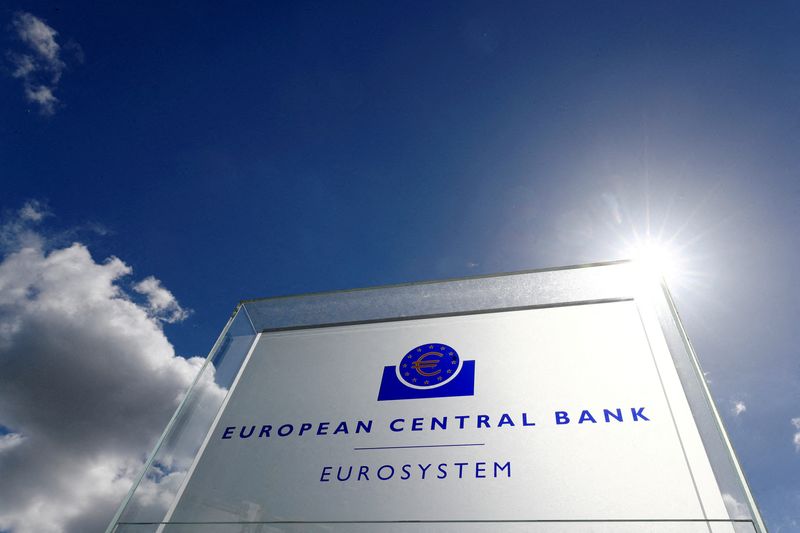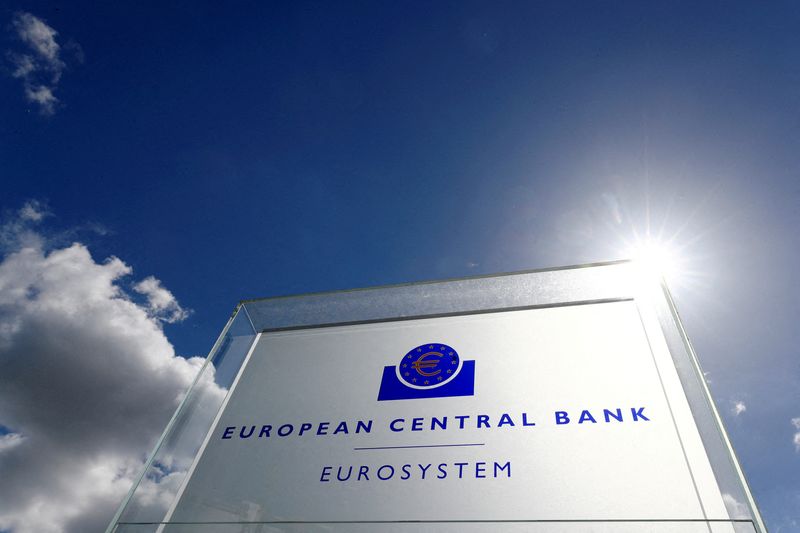Economy
ECB fans talk of September pause after raising rates to 23-year high


© Reuters. FILE PHOTO: The logo of the European Central Bank (ECB) is pictured outside its headquarters in Frankfurt, Germany, April 26, 2018. REUTERS/Kai Pfaffenbach//File Photo
(Corrects first paragraph to say .. in September ..not.. next month.)
By Balazs Koranyi and Francesco Canepa
FRANKFURT (Reuters) -The European Central Bank raised interest rates for the ninth consecutive time on Thursday but dialled up the possibility of a pause in September as stubbornly high inflation and recession worries pull policymakers in opposing directions.
Fighting off a historic surge in prices, the ECB has now lifted borrowing costs by a combined 425 basis points since last July, worried that price growth could be perpetuated by both rising costs and wages in an exceptionally tight jobs market.
With Thursday’s 25 basis point move, the ECB’s deposit rate stands at 3.75%, its highest level since 2000 – before euro notes and coins were even in circulation. The main refinancing rate was set at 4.25%.
ECB President Christine Lagarde said what comes next was in the balance, although the central bank was determined to “break the back” of inflation. It was widely criticised for a slow response to last year’s initial surge in prices.
She had responded to most of the questions at a press conference by saying all options remained on the table but sent the euro tumbling with a dovish flourish near the end.
“Do we have more ground to cover? At this point in time I wouldn’t say so,” Lagarde said, almost unprompted, while stressing that the ECB’s decisions would depend on the data.
“There is the possibility of a hike (next time). There is the possibility of a pause. It’s a decisive maybe.” Lagarde said, adding that policymakers were “open-minded” and unified.
Anna Stupnytska, a global macro economist at Fidelity International, said her comments meant the ECB was “now clearly countenancing pausing”.
Two sources said the balance of views had shifted on the Governing Council, with more policymakers than before now worried about a softening of the economy after a year in which concerns about inflation dominated.
Some policymakers currently favour a pause in September, expecting the euro zone to be heading into a recession, while others would prefer to raise borrowing costs again.
An ECB spokesperson declined to comment.
The ECB’s earlier policy statement said rates would be set at “sufficiently restrictive levels for as long as necessary” but dropped a reference to their having to be “brought” to a level that would cut inflation quickly enough to its 2% target.
Lagarde explained the tweak was “not random or irrelevant”.
INFLATION, RECESSION?
The problem is that inflation is coming down slowly and could take until 2025 to fall back to 2%, as a price surge initially driven by energy has seeped into the broader economy via large mark-ups and is fuelling the cost of services.
While overall inflation has halved from October, underlying price growth is hovering near historic highs and may have even accelerated this month.
Lagarde said the risks of so-called “second round” effects had not worsened since last month.
But record-low unemployment has raised fears that wages will jump as workers seek to recoup real incomes lost to inflation which is why many investors and analysts had been expecting the ECB to hike again in September pending autumn wage data.
“My overall sense is that everyone expected Lagarde to stress that the bank was data-dependent, and a little bit more hawkish (than the Fed) as is the ECB’s style,” Societe Generale (OTC:)’s FX strategist Kit Juckes said.
“But what was striking, was she has basically come out and said the net result of all the recent data was that it was not good.”
The euro tumbled as Lagarde spoke and briefly dipped under $1.10 having risen 0.5% to touch $1.1149 beforehand.
Markets had fully priced in another rate hike just a few weeks ago, but bets are growing that Thursday’s move will be the last, with the focus turning to how long rates will stay high.
“The bar for another hike in September is now dependent on upward surprises to inflation numbers, at a time when strong disinflationary forces are in play – so the default position is to keep rates constant for a sustained period,” RBC BlueBay portfolio manager Neil Mehta said.
More tightening would however be consistent with comments from policymakers including ECB board member Isabel Schnabel that raising rates too far would be less costly than not enough.
On Wednesday, the U.S. Federal Reserve raised borrowing costs and kept the door open to more, though Fed Chair Jerome Powell gave few hints about September.
Indicators of business, investor and consumer sentiment and bank lending surveys point to a continued deterioration after the euro zone skirted a recession last winter.
And with manufacturing in a deep recession and the previously resilient services sector showing signs of softening despite what is likely to be a superb summer holiday season, it is hard to see where any rebound would come from.
Such weakness, exacerbated by a loss of purchasing power after inflation eroded real incomes, could push down inflation faster than some expect, leaving less work for the ECB.
“We know we are getting closer,” Lagarde said, referring the end of the ECB’s rate hike run.
(Additional writing by Marc Jones in London; Editing by Catherine Evans)
Economy
Russian central bank says it needs months to make sure CPI falling before rate cuts -RBC


© Reuters. Russian Central Bank Governor Elvira Nabiullina attends a news conference in Moscow, Russia June 14, 2019. REUTERS/Shamil Zhumatov/File Photo
MOSCOW (Reuters) – Russia’s central bank will need two to three months to make sure that inflation is steadily declining before taking any decision on interest rate cuts, the bank’s governor Elvira Nabiullina told RBC media on Sunday.
The central bank raised its key interest rate by 100 basis points to 16% earlier in December, hiking for the fifth consecutive meeting in response to stubborn inflation, and suggested that its tightening cycle was nearly over.
Nabiullina said it was not yet clear when exactly the regulator would start cutting rates, however.
“We really need to make sure that inflation is steadily decreasing, that these are not one-off factors that can affect the rate of price growth in a particular month,” she said.
Nabiullina said the bank was taking into account a wide range of indicators but primarily those that “characterize the stability of inflation”.
“This will take two or three months or more – it depends on how much the wide range of indicators that characterize sustainable inflation declines,” she said.
The bank will next convene to set its benchmark rate on Feb. 16.
The governor also said the bank should have started monetary policy tightening earlier than in July, when it embarked on the rate-hiking cycle.
Economy
China identifies second set of projects in $140 billion spending plan


© Reuters. FILE PHOTO: Workers walk past an under-construction area with completed office towers in the background, in Shenzhen’s Qianhai new district, Guangdong province, China August 25, 2023. REUTERS/David Kirton/File Photo
SHANGHAI (Reuters) – China’s top planning body said on Saturday it had identified a second batch of public investment projects, including flood control and disaster relief programmes, under a bond issuance and investment plan announced in October to boost the economy.
With the latest tranche, China has now earmarked more than 800 billion yuan of its 1 trillion yuan ($140 billion) in additional government bond issuance in the fourth quarter, as it focuses on fiscal steps to shore up the flagging economy.
The National Development and Reform Commission (NDRC) said in a statement on Saturday it had identified 9,600 projects with planned investment of more than 560 billion yuan.
China’s economy, the world’s second largest, is struggling to regain its footing post-COVID-19 as policymakers grapple with tepid consumer demand, weak exports, falling foreign investment and a deepening real estate crisis.
The 1 trillion yuan in additional bond issuance will widen China’s 2023 budget deficit ratio to around 3.8 percent from 3 percent, the state-run Xinhua news agency has said.
“Construction of the projects will improve China’s flood control system, emergency response mechanism and disaster relief capabilities, and better protect people’s lives and property, so it is very significant,” the NDRC said.
The agency said it will coordinate with other government bodies to make sure that funds are allocated speedily for investment and that high standards of quality are maintained in project construction.
($1 = 7.1315 renminbi)
Economy
Russian central bank says it needs months to make sure CPI falling before rate cuts -RBC


© Reuters. Russian Central Bank Governor Elvira Nabiullina attends a news conference in Moscow, Russia June 14, 2019. REUTERS/Shamil Zhumatov/File Photo
MOSCOW (Reuters) – Russia’s central bank will need two to three months to make sure that inflation is steadily declining before taking any decision on interest rate cuts, the bank’s governor Elvira Nabiullina told RBC media on Sunday.
The central bank raised its key interest rate by 100 basis points to 16% earlier in December, hiking for the fifth consecutive meeting in response to stubborn inflation, and suggested that its tightening cycle was nearly over.
Nabiullina said it was not yet clear when exactly the regulator would start cutting rates, however.
“We really need to make sure that inflation is steadily decreasing, that these are not one-off factors that can affect the rate of price growth in a particular month,” she said.
Nabiullina said the bank was taking into account a wide range of indicators but primarily those that “characterize the stability of inflation”.
“This will take two or three months or more – it depends on how much the wide range of indicators that characterize sustainable inflation declines,” she said.
The bank will next convene to set its benchmark rate on Feb. 16.
The governor also said the bank should have started monetary policy tightening earlier than in July, when it embarked on the rate-hiking cycle.

 Forex2 years ago
Forex2 years agoForex Today: the dollar is gaining strength amid gloomy sentiment at the start of the Fed’s week

 Forex2 years ago
Forex2 years agoHow is the Australian dollar doing today?

 Forex1 year ago
Forex1 year agoUnbiased review of Pocket Option broker

 Forex2 years ago
Forex2 years agoDollar to pound sterling exchange rate today: Pound plummeted to its lowest since 1985

 Cryptocurrency2 years ago
Cryptocurrency2 years agoWhat happened in the crypto market – current events today

 World2 years ago
World2 years agoWhy are modern video games an art form?

 Stock Markets2 years ago
Stock Markets2 years agoMorgan Stanley: bear market rally to continue

 Economy2 years ago
Economy2 years agoCrude oil tankers double in price due to EU anti-Russian sanctions

































